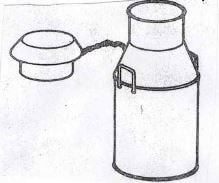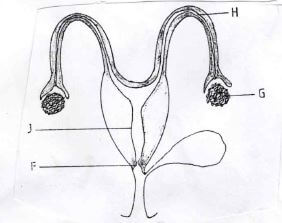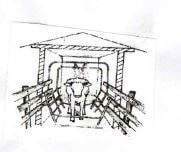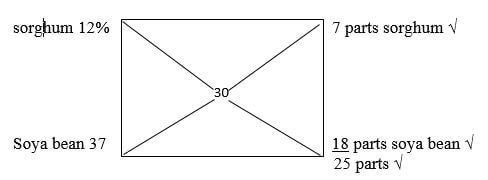INSTRUCTIONS TO CANDIDATES
- Write your name and index number in the spaces provided above.
- Sign and write the date of examination in the spaces provided above.
- This paper consists of three sections A, B and C.
- Answer all questions in Section A and B
- Answer any two questions from Section C
- Answer to ALL questions MUST be written in this booklet.

QUESTIONS
SECTION A: (30 MARKS)
Answer ALL questions in this section in the spaces provided.
- State two importance of good ventilation in animal houses. (1 mark)
- Outline four factors that affect the digestibility of a feed (2 marks)
- List four signs that shows a rabbit doe is about to give birth (2 marks)
- Explain the meaning of the following terms used in livestock production (2 marks)
- Chick
- Gilt
- Heterosis
- Kindling
- Give four maintenance measures for a crosscut saw. (2 marks)
- Name two tools used for checking the verticalness of a wall when laying bricks during construction. (1 mark)
- Give four reasons why a farmer should use concrete floors for dairy sheds. (2 marks)
- State the origins of the following breeds of livestock (2 marks)
- Charolais
- Toggenburg
- Merino
- Landrace
- Give four ways in which diseases can spread from one animal to other within the farm.(2 marks)
- Give four limitations of artificial insemination in cattle breeding (2 marks)
- State four functions of carbohydrate in the body of an animal (2 marks)
- Name two forms of which tapeworms are found in livestock (1 mark)
- Name six routine livestock rearing practices used to control parasites and diseases (3 marks)
- Outline four factors that influence the quality of honey (2 marks)
- State four ways in which animal utilizes a production ration (2 marks)
- Mention four reasons for treating timber before roofing farm buildings (2 marks)
SECTION B: (20 MARKS)
Answer ALL the questions in this section in the spaces provided.
- Below is an illustration of a farm equipment.

- Identify the equipment (1 mark)
- State the use of the equipment (1 mark)
- State three methods that can be used to sterilize the equipment (3 marks)
- A farmer wanted to mix 100kg of livestock feed containing 30% digestible crude protein (DCP) by using sorghum containing 12% digestible crude protein (DCP) and soya bean meal containing 37% digestible crude protein (DCP). Calculate the quantities of each feedstuff the farmer would have in the ration. (5 marks)
- The diagram below shows the reproductive system of a cow. Study it carefully and answer the questions that follow.

- Name the parts labeled F and H (2 marks)
- Give two functions of the part labeled G (2 marks)
- Give the role of the part labeled J (1 mark)
- The diagram below shows a farm structure. Use it to answer the questions that follow.

- Identify the practice being carried out. (1 mark)
- Name the structure in which the practice is being carried out. (1 mark)
- Give three advantages of the structure above over a plunge dip. (3 marks)
SECTION C:
Answer any TWO questions from this section in the spaces provided.
-
- Describe East Coast Fever (ECF) disease under the following sub-headings;
- Causative organism (1 mark)
- Animals affected (1 mark)
- Symptoms (6 marks)
- Control (2 marks)
- Explain six advantages of embryo transplant in livestock production (6 marks)
- State four functions of worker bees in a hive (4 marks)
- Describe East Coast Fever (ECF) disease under the following sub-headings;
-
- Describe the body confirmation features of a dairy heifer. (5 marks)
- Explain the uses of five various hand tools in the construction of a Kenya Top Bar hive (KTBH) (10 marks)
- Explain the factors that determine the amount of feed that an animal consumes (5 marks)
-
- Explain five factors considered when selecting livestock for breeding (10 marks)
- State five effects of fleas on livestock (5 marks)
- Explain five factors considered when siting a fish pond. (5 marks)

MARKING SCHEME
- Importance of good ventilation in animal houses.
- To have sufficient air circulation
- To regulate humidity inside the house
- To help regulate temperature inside the house(2 x ½m = 1 mark)
- Factors that affect the digestibility of a feed.
- Chemical composition of the feed
- Form in which the food is given/method of preparation
- Species of the animal
- The ratio of energy/carbohydrate to the proteins
- Feed mixtures and other ingredients in the feed
- Quantity of feed already present in the digestive system of the animal(4 x ½ = 2 marks)
- Signs that shows a rabbit doe is about to give birth
- Nest building
- Plucking of fur from her abdomen
- Restlessness
- Large/congested udder
- Loss of appetite
- Meaning of the following terms
- Chick – Newly hatched bird from one day to eight weeks old (½ mark)
- Gilt – A young female pig from weaning to farrowing (½ mark)
- Heterosis – Increased ability and performance of the offsprings above the average of two of unrelated parents (½ mark)
- Kindling – Act of giving birth/parturition in rabbits. (½ mark)
- Maintenance measures for a cross-cut saw (2 marks)
- Clean after use
- Set the teeth to the right angle
- Sharpen the teeth if blunt
- Replace broken handles
- Tighten loose screws (4 x ½ = 2 marks)
- Tools used for checking verticalness of a wall when laying bricks.
- Spirit level
- Plumb bob/plumbline(2 x ½m = 1 mark)
- Four reasons why a farmer should use concrete floors for dairy shed.
- Easy to clean
- Long lasting
- Do not encourage foot rot
- Aid in controlling parasites
- Help to prevent waterlogging
- Allow easy drainage of urine(4 x ½m = 2 marks)
- Origin of the following breeds;
- Charolais - France (½ mark)
- Toggenburg - Switzerland (½ mark)
- Merino - Spain (½ mark)
- Landrace - Denmark (½ mark)
- Four ways in which diseases can spread
- Through vectors
- Through eating contaminated food
- Through breeding/mating
- Through breathing in contaminated air
- Through surgical instruments
- Through sucking of young ones(4 x ½m = 2 marks)
- Limitation of artificial insemination in cattle breeding (2 marks)
- Harmful traits/diseases can be spread faster
- It requires trained personnel
- There are low chances of conceptions due to death of sperm
- Requires more labour than natural mating(4 x ½m = 2 marks)
- Functions of carbohydrates in the body of an animal.
- Supply of energy to carry out body processes
- Provide raw materials for the synthesis of animal products such as milk, meat and eggs.
- They aid in peristalsis
- Excess carbohydrates are converted to fat and stored under the skin providing insulation to the body.(4 x ½m = 2 marks)
- Forms of which tapeworms are found in livestock (1 mark)
- Embryo/infective egg
- Cysts/bladderworms/cysticercus/larva(2 x ½m = 1 mark)
- Routine livestock rearing practices used to control parasites and diseases.
- Vaccination
- Deworming
- Hoof trimming
- Docking
- Dipping/spraying
- Dusting(4 x ½m = 2 marks)
- Factors that influence the quality of honey
- Presence of impurities/foreign materials
- Source of nectar/type of flower
- The stage of ripening/maturity
- The method of extraction/honey harvesting
- Season of the year
- Rate of smoking(4 x ½m = 2 marks)
- Four ways in which animal utilizes a production ration. (2 marks)
- For synthesis of products such as milk and meat/for fattening
- For reproduction/foetal development/mating
- For growth in young animals
- For daily work/activities like ploughing and pulling carts(4 x ½m = 2 marks)
- Four reasons for treating timber
- Prevent attack from insects
- Prevent attack from fungi/rotting
- To resist weather conditions e.g. extreme temperature
- To resist water penetration
- To harden the wood/make it durable/increase strength
SECTION B: (20 marks)
-
- Identify the equipment
- Milk can/milk churn
- State the use of the equipment
- Keeping milk/carrying milk
- State three methods that can be use to sterilize the equipment
- Using sunlight
- Steam the equipment/use hot water treatment
- Use chemical sterilizers e.g biocide.
- Identify the equipment
- (5 marks)

Sorghum = 7 x 100kg = 28kg√
25
Soya beans = 18 x 100kg = 72kg √
25 -
-
- F – cervix (1 mark)
- H – Oviduct/fallopian tube
-
- Produce ova/ female gametes
- Produce hormones that control ovulation and pregnancy.
-
-
- Identify the practice being carried out.
Spraying/tick control - Name the structure in which the practice is being carried out.
Spray race. - Give three advantages of the structure above over a plunge dip
- Suitable for pregnant and sick animals as they do not get shock.
- It is economical-the acaricide wash is not wasted since it is re-cycled in the process. It also requires a small amount of acaricide wash.
- Animals cannot swallow the acaricide wash ie no poisoning of animals.
- Spraying is faster ie can spray more animals per hour than a plunge dip since animals walk through the spray race.
- Less labour is required
- Small stock eg sheep can easily be sprayed.
- Identify the practice being carried out.
Download Agriculture Paper 2 Pre Mock Questions and Answers - Mokasa I Joint Examination July 2021.
Tap Here to Download for 50/-
Get on WhatsApp for 50/-
Why download?
- ✔ To read offline at any time.
- ✔ To Print at your convenience
- ✔ Share Easily with Friends / Students

